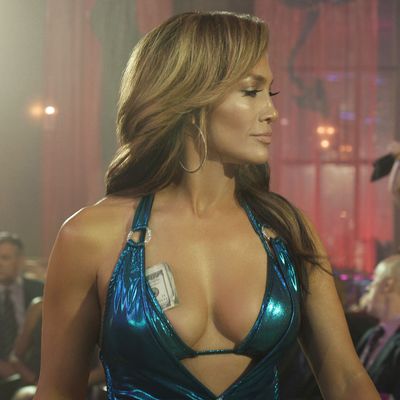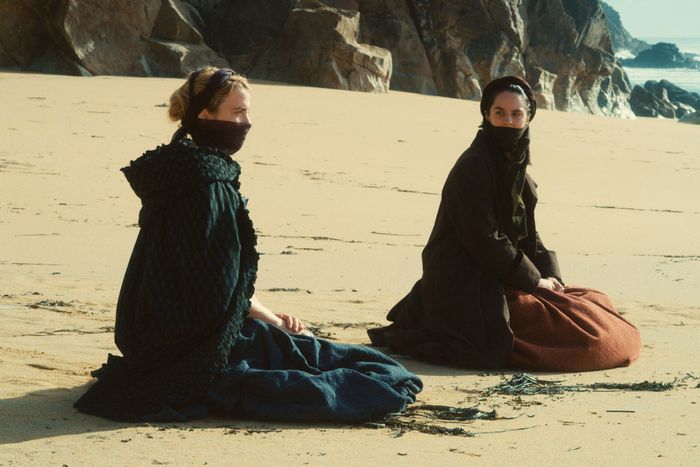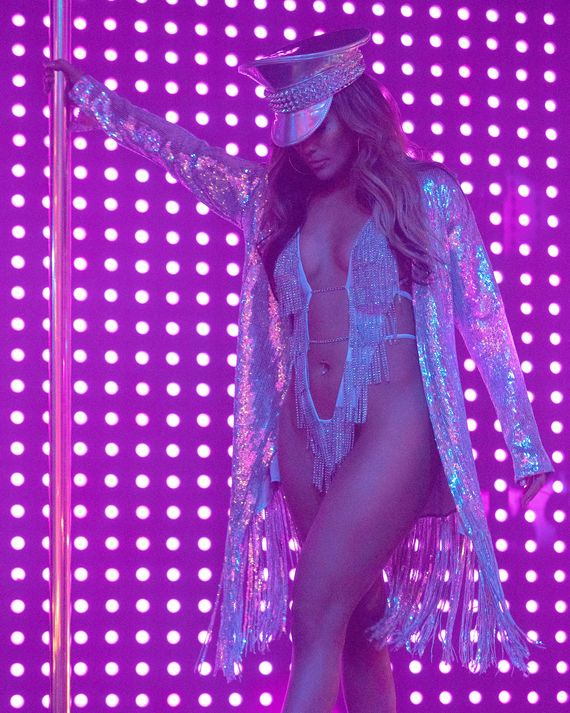
Marianne (Noémie Merlant), the protagonist of Portrait of a Lady on Fire, is stealing peeks at Héloïse (Adèle Haenel) while walking behind her, studying the blonde hair revealed when her hood falls around her shoulders, daring sidelong glances at her silhouette as they stand side by side facing the sea. The love affair in Céline Sciamma’s film is one that unfolds in looks like these, which grow longer and more intense as the two women grow closer. But at first, Marianne can only see the woman she’s been hired to secretly paint in pieces, sketching remembered fragments of Héloïse’s face back in her room. There’s a terrible irony to this task; the portrait is intended for a Milanese man who’ll use it to assess whether the woman it depicts will make for an acceptable bride. Portrait of a Lady on Fire is all about women’s art and relationships in a world defined by men, and the entire time I was watching it, I couldn’t stop thinking about Hustlers.
The concept of the male gaze isn’t a tough one to grok, whether you’ve read film theorist Laura Mulvey’s famous 1975 essay about it or not. It’s widespread, the default, the point of view of implicit power and heterosexual lust. It’s an offscreen Italian guy who’s going to glance at a piece of art and decide if he wants to fuck its subject. But to watch Sciamma’s period drama and Lorene Scafaria’s stripper saga — films separated by a few centuries, a few thousand miles, and at least a few dozen yards of costuming fabric — is to be reminded that no one, including women who shoot films, is in full agreement as to what the female gaze looks like. Both movies are about women who make a living catering to male desire but who are only truly seen by one another. Both evoke that truth with camerawork that echoes the perspectives of its main characters. In Portrait of a Lady on Fire, that gaze, and the relationship that grows out of it, are able to flourish because the characters are temporarily together on a remote estate where only women seem to be around. Hustlers, which also has the advantage of 21st-century liberties, takes place right in the middle of a business designed to cater to men who want to watch.
There’s a lot of weighty deliberation to Sciamma’s movie, which constantly calls attention to the act of looking and who’s doing it by having its framing replicate its main character’s point of view, a one-way observation that shifts to something mutual as her lover eventually starts staring back. In some ways, it made me appreciate the liberation of Scafaria’s film even more — how aware it is of the eyes of the men who fill the club, wait in the Champagne Room, and become eventual targets for the scam, and how little obligation it feels to drop us into their perspective. That indifference is apparent from one of its earliest and greatest sequences, in which Jennifer Lopez’s Ramona walks into the movie and onto the stage to pole-dance to Fiona Apple’s “Criminal.” The number is shot slightly from below, looking up at an angle that makes Lopez loom tall in the frame. It replicates the perspective not of the appreciative patrons clustered by the stage but of Destiny (Constance Wu), who’s standing awestruck out on the floor. The film cuts between Ramona’s performance and Destiny’s face as she watches, and never closes in on any one part of Lopez’s body. The intention is not to evoke the lust of the money-hurling mass of customers but to show us Ramona the way Destiny sees her, as this powerful, enviable whole.
Later, when Destiny finds Ramona out on the club’s rooftop, smoking a cigarette while sprawled out in her fur coat, it’s a tableau that’s both glorious and solitary, the skyline behind her and the city seemingly at her feet. When Ramona glides through the club, it’s inevitably in slow motion and sometimes with other characters in formation around her like a conquering army. It’s an effect that anoints her, and eventually Destiny, with a sense of ownership. The movie shoots the club as a women’s workplace, cinematographer Todd Banhazl’s camera tracking Destiny as she works the floor or darting around to catch the other characters on the job. The dressing room is a whole other space, physically and mentally. It’s cluttered and bright, and the way it’s shot — the camera crowds companionably in at eye level as though it’s just one of the girls, utterly matter-of-fact about any skin on display — has more in common with the look of Ramona’s airy Upper East Side apartment than the inside of the club.
The closest the film comes to giving us a customer’s perspective is when it shows us Destiny and Ramona in a striptease double act in the club’s backroom, and even then, the angles are reminiscent of the ways the characters study themselves in a mirror, strategically assessing their own allure. When Destiny is demeaned by a customer trying to coax his way into a blowjob, the camera gets low with her on the ground, emphasizing her feelings of powerlessness and not the perspective of the man looking down at her. And when a client gets handsy with Ramona, the camera holds on her face as she strides away — a contrast with her closeness with Destiny, whom she tucks into her fur coat, whose hands she clasps at the diner, and whose head she cradles in her lap at her grandmother’s funeral. Warmth comes easily to Ramona, but dependability is another matter, and the way she’s framed reveals itself to be a reflection of Destiny’s fears of abandonment. Ramona stands on stages and lounges on rooftops and lives up in apartment towers, near but always threatening to rise out of reach.
Ramona has a line, not long after the women start their scheme of drugging men into financial submission, about how they “weren’t just some disposable dancers anymore.” But in the film, it’s their marks who are portrayed as disposable, a series of interchangeable figures passing out after sloppily signing for enormous bills. An initial montage of targets at one point finds the women piling into one side of an SUV with a stoned patsy and emerging directly out the other door at the club with another. It’s only when one of their victims come sharply and unignorably into focus that they run into trouble, and the movie stops allowing its primary characters to pretend they’re just getting their own in a rigged system and not also causing harm to individuals. Even then, it’s not what will bring about their inevitable downfall that’s the question — it’s whether the friendship at the heart of the film is real.
Portrait of a Lady on Fire hasn’t reached U.S. theaters yet. When it does arrive in December, it’ll be with the kind of fanfare that tends to accompany a film that was acclaimed when it premiered at Cannes (where it won the Queer Palm as well as the award for screenplay) and that’s since had pride of place at a slew of other festivals around the world. It’ll be taken seriously, whereas Hustlers, which had an abrupt if glittery premiere at Toronto a few days before it reached theaters, has tended to be treated as a romp, a possible Oscar vehicle for Lopez, and not much more. But just because it plays as light doesn’t preclude its having depth, and its own provocative take on the female gaze as something that doesn’t need to be underscored by the absence of men to exist. Hustlers makes it look so deceptively easy, like it’s ridiculous that we haven’t had all along a frictionless shift of perspective and narrative agency to characters who’ve traditionally been regarded as things to be gazed at.
The greatest trick Hustlers pulls off is the way it’s able to convey that Ramona is a platonic source of desire for Destiny — she’s a friend and a maternal surrogate, but also a figure who can’t entirely be understood or trusted. Ramona is allowed to be a little distant, to be a receptacle of doubt and longing, to be seen subjectively without being reduced to an accessory who only exists in another character’s head. Unlike Marianne, Destiny’s able to look straight on at the object of her affection from the start — though that doesn’t translate to her feeling like she’s knows her. When the camera tracks Ramona’s Juicy Coutured figure down the sidewalk as “Royals” plays and the criminal enterprise reaches its inevitable end point, it still looks as though it’s trying to catch up with her. Of course, the ones who actually accomplish that are the cops.




